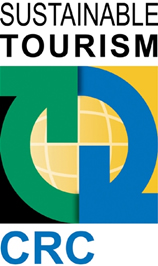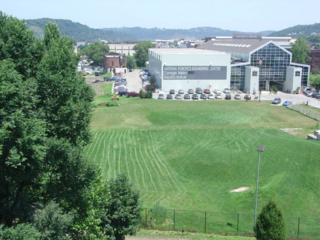
The University of New South Wales (UNSW), also known as UNSW Sydney, is a public research university based in Sydney, New South Wales, Australia. It is one of the founding members of Group of Eight, a coalition of Australian research-intensive universities.

Southern Cross University (SCU) is an Australian public university, with campuses at Lismore and Coffs Harbour in northern New South Wales, and at Coolangatta, the most southern suburb of the Gold Coast in Queensland. In 2019, it was ranked in the top 100 young universities in the world by the Times Higher Education World University Rankings.
Robotic mapping is a discipline related to computer vision and cartography. The goal for an autonomous robot is to be able to construct a map or floor plan and to localize itself and its recharging bases or beacons in it. Robotic mapping is that branch which deals with the study and application of ability to localize itself in a map / plan and sometimes to construct the map or floor plan by the autonomous robot.

The Molonglo Observatory Synthesis Telescope (MOST) is a radio telescope operating at 843 MHz. It is operated by the School of Physics of the University of Sydney. The telescope is located in Hoskinstown, near the Molonglo River and Canberra, and was constructed by modification of the east–west arm of the former Molonglo Cross Telescope, a larger version of the Mills Cross Telescope. Construction of the original "Super Cross" telescope with 1.6-kilometre arms began in 1960 by Professor Bernard Y. Mills. It became operational in 1967.

An autonomous underwater vehicle (AUV) is a robot that travels underwater without requiring continuous input from an operator. AUVs constitute part of a larger group of undersea systems known as unmanned underwater vehicles, a classification that includes non-autonomous remotely operated underwater vehicles (ROVs) – controlled and powered from the surface by an operator/pilot via an umbilical or using remote control. In military applications an AUV is more often referred to as an unmanned undersea vehicle (UUV). Underwater gliders are a subclass of AUVs.
The Australian Research Council (ARC) is the primary non-medical research funding agency of the Australian Government, distributing more than A$800 million in grants each year. The Council was established by the Australian Research Council Act 2001, and provides competitive research funding to academics and researchers at Australian universities. Most health and medical research in Australia is funded by the more specialised National Health and Medical Research Council (NHMRC), which operates under a separate budget.
Hugh Francis Durrant-Whyte is a British-Australian engineer and academic. He is known for his pioneering work on probabilistic methods for robotics. The algorithms developed in his group since the early 1990s permit autonomous vehicles to deal with uncertainty and to localize themselves despite noisy sensor readings using simultaneous localization and mapping (SLAM).
The terms design computing and other relevant terms including design and computation and computational design refer to the study and practice of design activities through the application and development of novel ideas and techniques in computing. One of the early groups to coin this term was the Key Centre of Design Computing and Cognition at the University of Sydney in Australia, which for nearly fifty years pioneered the research, teaching, and consulting of design and computational technologies. This group organised the academic conference series "Artificial Intelligence in Design (AID)" published by Springer during that period. AID was later renamed "Design Computing and Cognition (DCC)" and is currently a leading biannual conference in the field. Other notable groups in this area are the Design and Computation group at Massachusetts Institute of Technology's School of Architecture + Planning and the Computational Design group at Georgia Tech.

An agricultural robot is a robot deployed for agricultural purposes. The main area of application of robots in agriculture today is at the harvesting stage. Emerging applications of robots or drones in agriculture include weed control, cloud seeding, planting seeds, harvesting, environmental monitoring and soil analysis. According to Verified Market Research, the agricultural robots market is expected to reach $11.58 billion by 2025.

Sustainable Tourism Cooperative Research Centre (STCRC),was an Australian Cooperative Research Centre, headquartered in Gold Coast, Queensland, established by the Australian Government's Cooperative Research Centers Program to establish a competitive and dynamic sustainable tourism industry in Australia. It ceased to operate on 30 June 2010.

Ronald Craig Arkin is an American roboticist and roboethicist, and a Regents' Professor in the School of Interactive Computing, College of Computing at the Georgia Institute of Technology. He is known for the motor schema technique in robot navigation and for his book Behavior-Based Robotics.

The Multi Autonomous Ground-robotic International Challenge (MAGIC) is a 1.6 million dollar prize competition for autonomous mobile robots funded by TARDEC and the DSTO, the primary research organizations for Tank and Defense research in the United States and Australia respectively. The goal of the competition is to create multi-vehicle robotic teams that can execute an intelligence, surveillance and reconnaissance mission in a dynamic urban environment. The challenge required competitors to map a 500 m x 500 m challenge area in under 3.5 hours and to correctly locate, classify and recognise all simulated threats. The challenge event was conducted in Adelaide, Australia, during November 2010.
The Learning Applied to Ground Vehicles (LAGR) program, which ran from 2004 until 2008, had the goal of accelerating progress in autonomous, perception-based, off-road navigation in robotic unmanned ground vehicles (UGVs). LAGR was funded by DARPA, a research agency of the United States Department of Defense.

The National Robotics Engineering Center (NREC) is an operating unit within the Robotics Institute (RI) of Carnegie Mellon University. NREC works closely with government and industry clients to apply robotic technologies to real-world processes and products, including unmanned vehicle and platform design, autonomy, sensing and image processing, machine learning, manipulation, and human–robot interaction.
Peter Corke is an Australian roboticist known for his work on Visual Servoing, field robotics, online education, the online Robot Academy and the Robotics Toolbox and Machine Vision Toolbox for MATLAB. He is currently director of the Australian Research Council Centre of Excellence for Robotic Vision, and a Distinguished Professor of Robotic Vision at Queensland University of Technology. His research is concerned with robotic vision, flying robots and farming robots.
The Australian Centre for Robotic Vision, formerly Australian Research Council Centre of Excellence for Robotic Vision or ARC Centre of Excellence for Robotic Vision, is an unincorporated collaborative venture with funding of A$25.6m over seven years to pursue a research agenda tackling the critical and complex challenge of applying robotics in the real world.
Kourosh Kalantar-zadeh is an Australian scientist involved in research in the fields of materials sciences, electronics, and transducers. He is best known for his works on two-dimensional semiconductors, ingestible sensors and liquid metals. He led his group to the invention of an ingestible chemical sensor: human gas sensing capsule.
The ARC Centre of Excellence for Automated Decision-Making and Society (ADM+S) is a multi-institutional, multi-disciplinary research centre based at RMIT University in Melbourne, Australia. The Centre aims to contribute to the knowledge and strategies necessary for responsible, ethical and inclusive automated decision-making (ADM). It was established in 2020 with funding from the Australian Government through the Australian Research Council (ARC) and other partners. The Centre examines the social and technical aspects of ADM, seeing automated systems as the outcomes of interactions between people, machines, data and institutions. It has a particular focus on the domains of news and media, transport and mobility, social services and health.
Matthew Johnson-Roberson is an American roboticist, researcher, entrepreneur and educator. Since January 2022 he has served as director of the Robotics Institute at Carnegie Mellon University. Previously he was a professor at the University of Michigan College of Engineering since 2013, where he co-directed the UM Ford Center for Autonomous Vehicles (FCAV) with Ram Vasudevan. His research focuses on computer vision and artificial intelligence, with the specific applications of autonomous underwater vehicles and self-driving cars. He is also the co-founder and CTO of Refraction AI, a company focused on providing autonomous last mile delivery.








